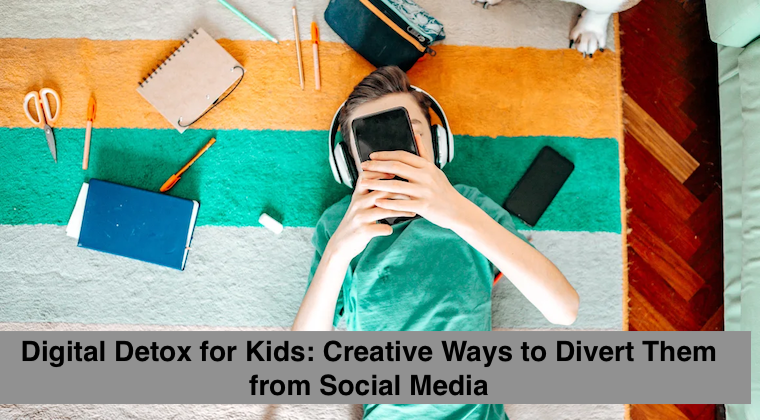
Children now devote more time to social media than in any previous era of digital technology. Social media platforms including Instagram, TikTok and Snapchat entertain users while enabling friendship connections but excessive usage typically results in negative consequences. The utilization of social media generates various adverse consequences that span from deteriorating focus span to mental health problems and low self-esteem issues. The well-being of children demands that parents support digital detox practices. Parents should assist their children to discover alternative social media platforms which will help them develop better lifestyle choices. A digital detox for kids becomes enjoyable and interactive when parents invest sufficient time and effort. The following approach will help children discover healthier activities which bring fulfillment to their lives.
Why Social Media Can Be Harmful
Social media presents an unproblematic exterior at its beginning but it produces worrying effects throughout prolonged usage. Children spend numerous hours browsing through social media content while watching videos and interacting with friends online. The habit of spending too much time on social media develops into an addiction throughout the duration. Social media platforms function through continuous user interaction which results in prolonged periods of platform usage.
The constant online activities performed by children result in lost time that could have been spent on valuable pursuits including education and outdoor activities and rest. Children feel compelled to show flawless online personas which creates social comparison problems that produce self-doubt. The negative impact on their self-esteem and the development of anxiety or depression results from this behavior.
The main problem arises from interrupted sleep patterns. Before going to sleep most children access their phones which disrupts their sleep patterns and their capacity to get proper rest. Parents can establish better digital habits for their children by first understanding the obstacles they face.
Set Clear and Friendly Boundaries
The process of establishing screen time limits requires both clear boundaries and a supportive environment that makes sense to children. Children become more receptive to rules when they participate in the process of establishing them. You should explain the importance behind screen-free times while seeking their assistance to determine the most suitable approach.
Some effective rules might include:
- The dinner table should be a phone-free area because it promotes family discussions.
- The practice of avoiding technology during the final hour of the day helps people achieve better sleep quality.
- All family members should avoid using screens when they go to the park or watch movies together.
You should create specific areas in your home which remain technology-free such as dining spaces and bedrooms. The effectiveness of these boundaries depends on parents modeling the behavior which they want their children to learn. The practice of ignoring your phone during meals will prevent kids from following your rules. The demonstration of these rules by you teaches children that they apply to everyone including yourself.
Introduce Fun Offline Activities
You should replace social media time with more attractive offline activities to divert your children’s attention. The use of screens by children often results from boredom so providing them with interesting offline activities produces significant benefits.
Several activities can help capture their attention.
- Creative hobbies: Show your support for activities like painting, drawing, crafting and writing. The activities keep children busy while helping them build creativity and problem-solving abilities.
- Physical activities: The combination of sports along with dance and yoga and basic games such as tag and hide-and-seek provides excellent opportunities to maintain physical wellness and health. The practice of physical exercise simultaneously raises mood levels and decreases stress.
- Family bonding: Plan regular family events that include board games together with movie nights and weekend hiking activities. These bonding moments help you build lasting memories and improve your connection with each other.
- Learning new skills: Teach them practical skills like cooking, gardening, or building something with their hands. These activities serve as both entertaining and instructive experiences.Choose activities that match your child’s personal interests. The zoo or animal shelter volunteer work would be a great fit for children who love animals. Music fans should learn musical instruments or write their own songs.
Teach Smart Tech Use
The usage of screens does not always result in negative consequences. Technology functions as a beneficial educational resource for learning and creativity when people use it correctly. Show your children the proper usage of their devices for creating valuable educational content instead of mindless social media scrolling.
Introduce the children to educational applications that include coding games together with virtual art studios and language-learning tools. Let your child use their devices to pursue their interests through video production or digital photo editing or creative writing. When children realize their devices have uses beyond scrolling they develop better control and empowerment over their digital habits.
You should discuss with your child why they need to maintain equilibrium. You should show your children how to detect online usage limits and then guide them toward offline activities. App-based screen time tracking features help parents monitor their child’s device usage together.
Encourage Face-to-Face Socializing
A child needs face-to-face interactions to develop emotionally and socially. Online chatting provides enjoyment but does not substitute the essential value of personal interaction. Your child should dedicate more time to real-life interactions with their friends and family members.
You should arrange playdates and host sleepovers for their friends or help them join sports teams or clubs. Scouting together with drama classes and community service projects enable children to build friendships while they learn teamwork abilities and leadership competencies.
Begin with tiny steps when your child shows fear of social activities. Start by letting your child visit a nearby friend or join a relaxed hobby-based group that makes them feel at ease. Through time your child will develop greater self-assurance regarding their relationships with others.
Be Patient and Consistent
The process of changing social media habits in children requires extended periods of time. Allow your child to adapt to new habits since you need patience during this process. You should appreciate every minor achievement when your child avoids screens during weekends or chooses outdoor activities over phone scrolling.
Maintain the rules you have established with consistent enforcement. Too frequent exceptions will make children resist the established boundaries. The rule should be clear but it should not be unyielding. You should listen to your child while making rule changes to discover the best approach for your family.
The main objective is not to ban social media completely but to establish healthy boundaries that promote kid wellness. A digital detox for children enables them to withdraw from devices while creating better digital habits. Through time your children will master technology usage to improve their daily existence rather than letting technology control them.
The goal of helping children leave social media is to point them toward healthier activities that bring deeper meaning rather than limiting their freedom. Children can experience a digital detox by following set boundaries and discovering new activities and learning responsible technology use. The actions you take now will help your child build lasting habits that will benefit them throughout their future years. Change requires patience yet with enough love it becomes possible.


